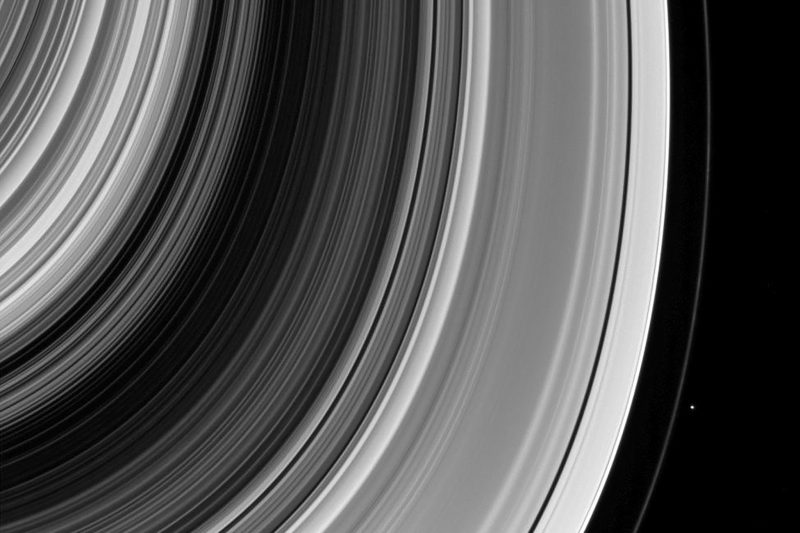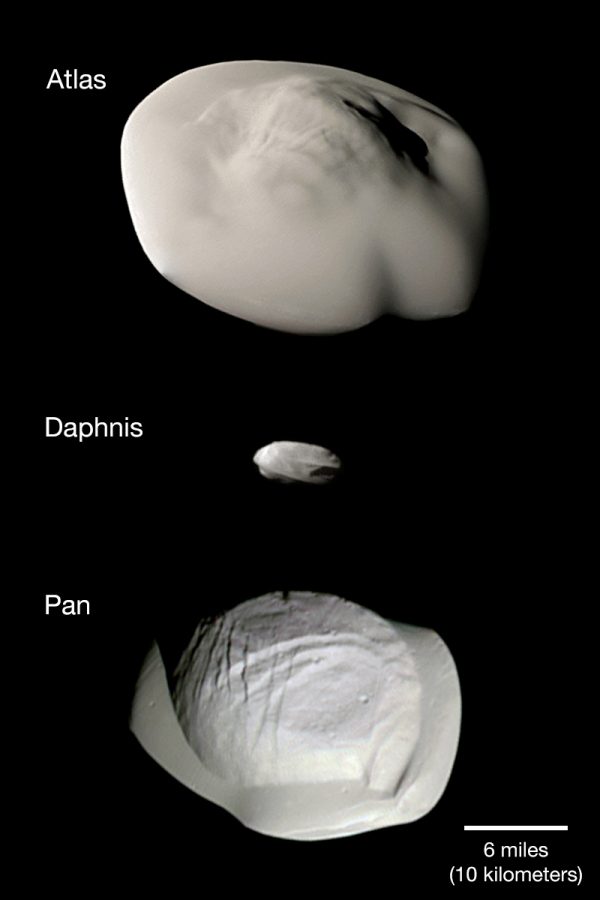
New findings have emerged about five tiny moons nestled in and near Saturn’s rings. Super-close flybys by NASA’s Cassini spacecraft – which orbited Saturn from 2004 to 2017 – reveal that the surfaces of these unusual moons are covered with material from the planet’s rings – and from icy particles blasting out of Saturn’s larger moon Enceladus.
Planet Saturn has 62 moons, ranging in size from tiny moonlets less than .6 miles (1 kilometer) across to the enormous Titan, which is larger than the planet Mercury. The five moons inspected by Cassini were Atlas, Epimetheus, Pandora, Daphnis and Pan.
Bonnie Buratti of NASA’s Jet Propulsion Laboratory is lead author of the study, published in the journal Science on March 28, 2019. She said in a statement:
The daring, close flybys of these odd little moons let us peer into how they interact with Saturn’s rings. We’re seeing more evidence of how extremely active and dynamic the Saturn ring and moon system is.
The new research, from data gathered by Cassini’s instruments before the spacecraft plunged into Saturn’s atmosphere in 2017, suggests that dust and ice from the rings accretes onto the moons embedded within and near the rings.
Scientists also found the moon surfaces to be highly porous, which, the researchers say, helps confirm the theory that they were formed in multiple stages as ring material settled onto denser cores that might be remnants of a larger object that broke apart. The porosity also helps explain their shape: Rather than being spherical, these moons are blobby and ravioli-like, with material stuck around their equators. Buratti said:
We found these moons are scooping up particles of ice and dust from the rings to form the little skirts around their equators. A denser body would be more ball-shaped because gravity would pull the material in.

Cassini Project Scientist Linda Spilker said:
Perhaps this process is going on throughout the rings, and the largest ring particles are also accreting ring material around them. Detailed views of these tiny ring moons may tell us more about the behavior of the ring particles themselves.

Of the satellites studied, the surfaces of those closest to Saturn – Daphnis and Pan – are the most altered by ring materials, according to the researchers. The surfaces of the moons Atlas, Epimetheus and Pandora, farther out from Saturn, have ring material as well – but they’re also coated with the bright icy particles and water vapor from the plume spraying out of Enceladus. (A broad outer ring of Saturn, known as the E ring, is formed by the icy material that fans out from Enceladus’ plume.)
Astronomers don’t know what triggered the moons to form.
Cassini’s mission ended in September 2017, when it was low on fuel. Mission controllers deliberately plunged Cassini into Saturn’s atmosphere rather than risk crashing the spacecraft into the planet’s moons.
Bottom line: New research using data from the Cassini spacecraft says that dust and ice from Saturn’s rings accumulate on moons orbiting in the rings’ vicinity.
Source: Close Cassini flybys of Saturn’s ring moons Pan, Daphnis, Atlas, Pandora, and Epimetheus











